At-home workouts have become increasingly popular in recent years as people look to exercise from the comfort of their own homes.
With the rise of technology and online fitness programs, it’s never been easier to get a full-body workout without ever leaving your living room.
At-home workouts offer a convenient and cost-effective alternative to traditional gym memberships. They allow individuals to exercise on their own time and at their own pace.
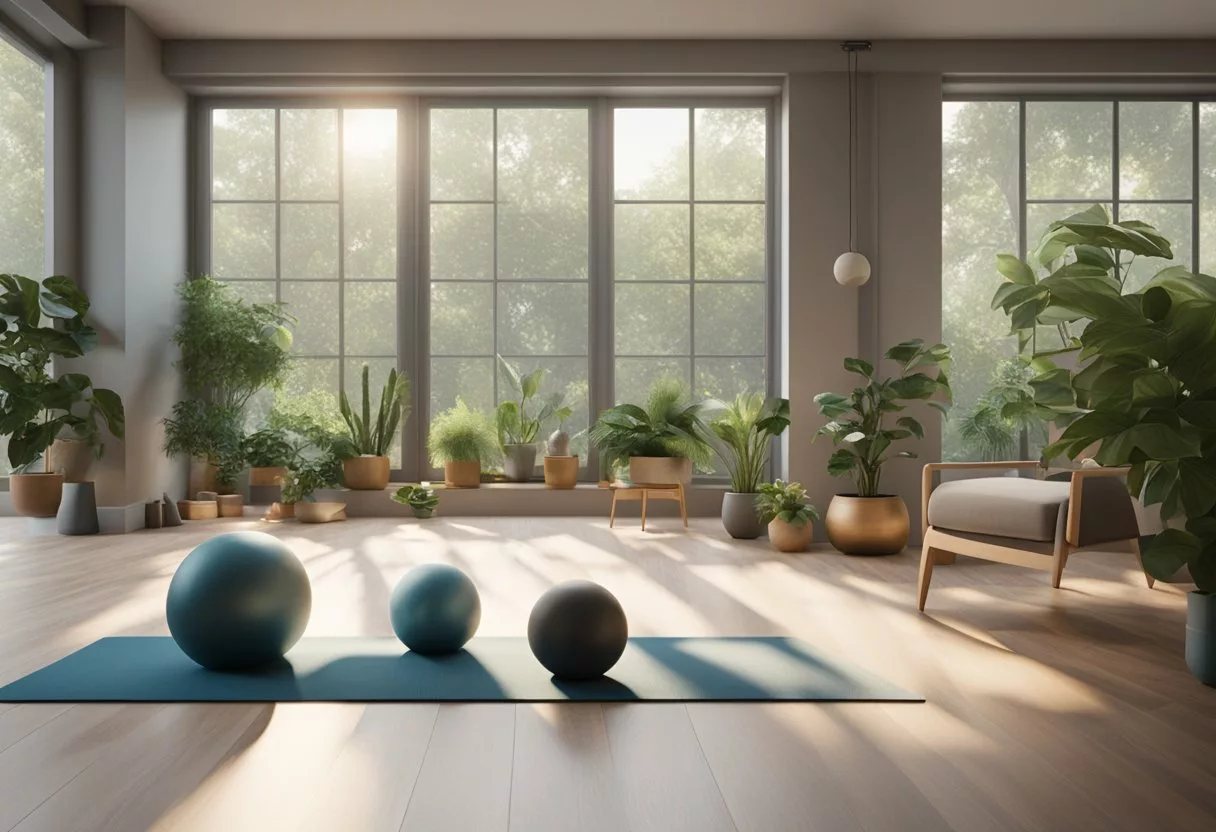
One of the biggest benefits of at-home workouts is the flexibility they offer.
Individuals can tailor their workouts to fit their schedules and fitness goals, without the added pressure of having to commute to a gym or attend scheduled classes.
Additionally, at-home workouts are often less intimidating than traditional gym settings, making them a great option for beginners or those who feel self-conscious about exercising in public.
Key Takeaways
- At-home workouts offer a convenient and cost-effective alternative to traditional gym memberships.
- They provide flexibility and can be tailored to fit individual schedules and fitness goals.
- At-home workouts are often less intimidating than traditional gym settings, making them a great option for beginners.
Benefits of At-Home Workouts
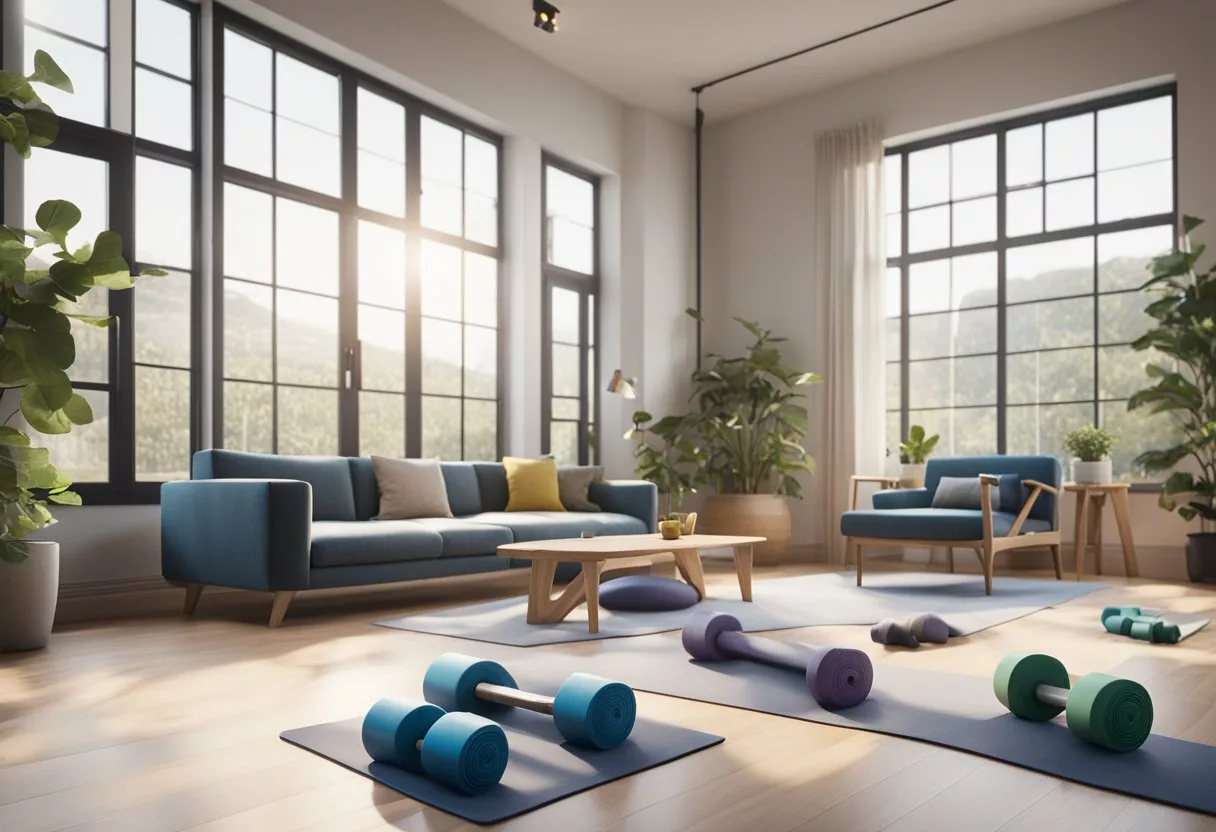
At-home workouts have gained popularity in recent years due to their numerous benefits. Here are some of the benefits of at-home workouts:
Cost-Effectiveness
One of the main benefits of at-home workouts is their cost-effectiveness.
Gym memberships can be expensive, and the cost can add up over time.
On the other hand, at-home workouts require little to no equipment, and many exercises can be done with just body weight.
This makes at-home workouts a more affordable option for those on a budget.
Convenience and Flexibility
At-home workouts offer convenience and flexibility.
With at-home workouts, one can exercise anytime, anywhere, without having to worry about gym hours or commuting time. This makes it easier to fit exercise into a busy schedule.
Additionally, at-home workouts can be customized to fit individual needs and preferences, allowing for more flexibility in terms of exercise routine.
Privacy and Comfort
At-home workouts offer privacy and comfort.
Some people may feel self-conscious exercising in a gym or public space. At-home workouts offer a more private setting, allowing individuals to exercise without feeling self-conscious.
Additionally, at-home workouts allow for greater control over the environment, such as temperature and music, making the workout more comfortable and enjoyable.
Research has shown that at-home workouts can be just as effective as gym workouts in terms of improving fitness and health. However, it is important to note that at-home workouts may not be suitable for everyone.
Individuals with certain health conditions or injuries may require specialized equipment or supervision, and should consult with a healthcare professional before starting an exercise routine.
Essential Equipment for Home Workouts
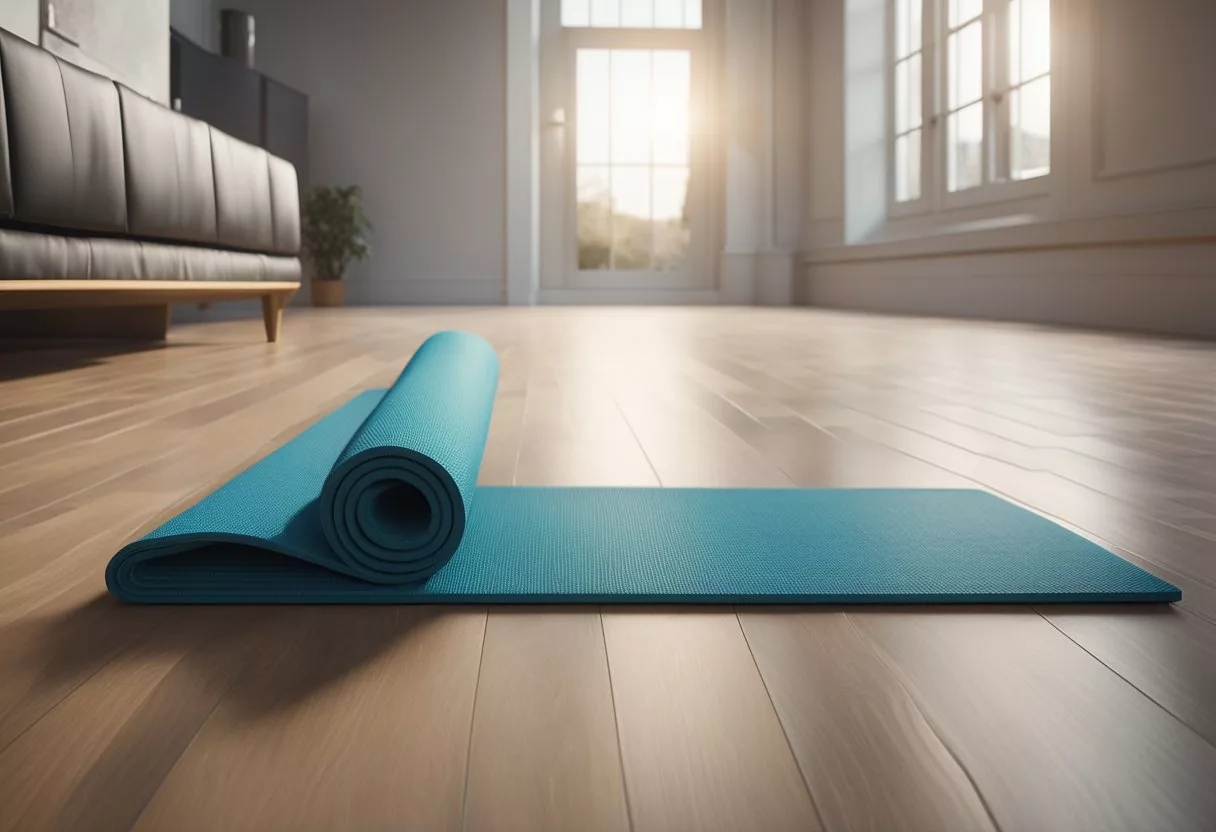
When it comes to home workouts, having the right equipment can make all the difference.
Whether you’re a beginner or an experienced fitness enthusiast, there are a few essential pieces of equipment that can help you achieve your fitness goals.
In this section, we’ll cover the most important equipment for home workouts, including bodyweight exercises, resistance training tools, and cardio equipment options.
Bodyweight Exercises
Bodyweight exercises are a great way to build strength and improve your overall fitness without any equipment.
These exercises use your own body weight as resistance, making them a convenient and cost-effective option for at-home workouts. Some popular bodyweight exercises include:
- Push-ups
- Squats
- Lunges
- Planks
- Burpees
Resistance Training Tools
Resistance training tools can help you build muscle and increase strength.
While dumbbells and kettlebells are popular options, there are also other tools that can be used for resistance training at home. Here are some of the most effective resistance training tools:
- Dumbbells: Dumbbells are versatile and can be used for a variety of exercises, including bicep curls, shoulder presses, and lunges.
- Resistance bands: Resistance bands are lightweight and portable, making them a great option for at-home workouts. They can be used for a variety of exercises, including rows, chest presses, and leg lifts.
- Kettlebells: Kettlebells are great for building strength and endurance. They can be used for exercises like kettlebell swings, goblet squats, and Turkish get-ups.
Cardio Equipment Options
Cardio equipment can help you burn calories and improve your cardiovascular health.
While treadmills and stationary bikes are popular options, there are also other equipment options that can be used for cardio workouts at home. Here are some of the best cardio equipment options:
- Treadmills: Treadmills are great for running and walking workouts. They can help you burn calories and improve your cardiovascular health.
- Stationary bikes: Stationary bikes are a low-impact option for cardio workouts. They can help you build endurance and improve your cardiovascular health.
- Jump ropes: Jump ropes are a simple and effective way to get your heart rate up. They can be used for a variety of cardio workouts, including high-intensity interval training (HIIT) and circuit training.
Creating Your Home Workout Plan
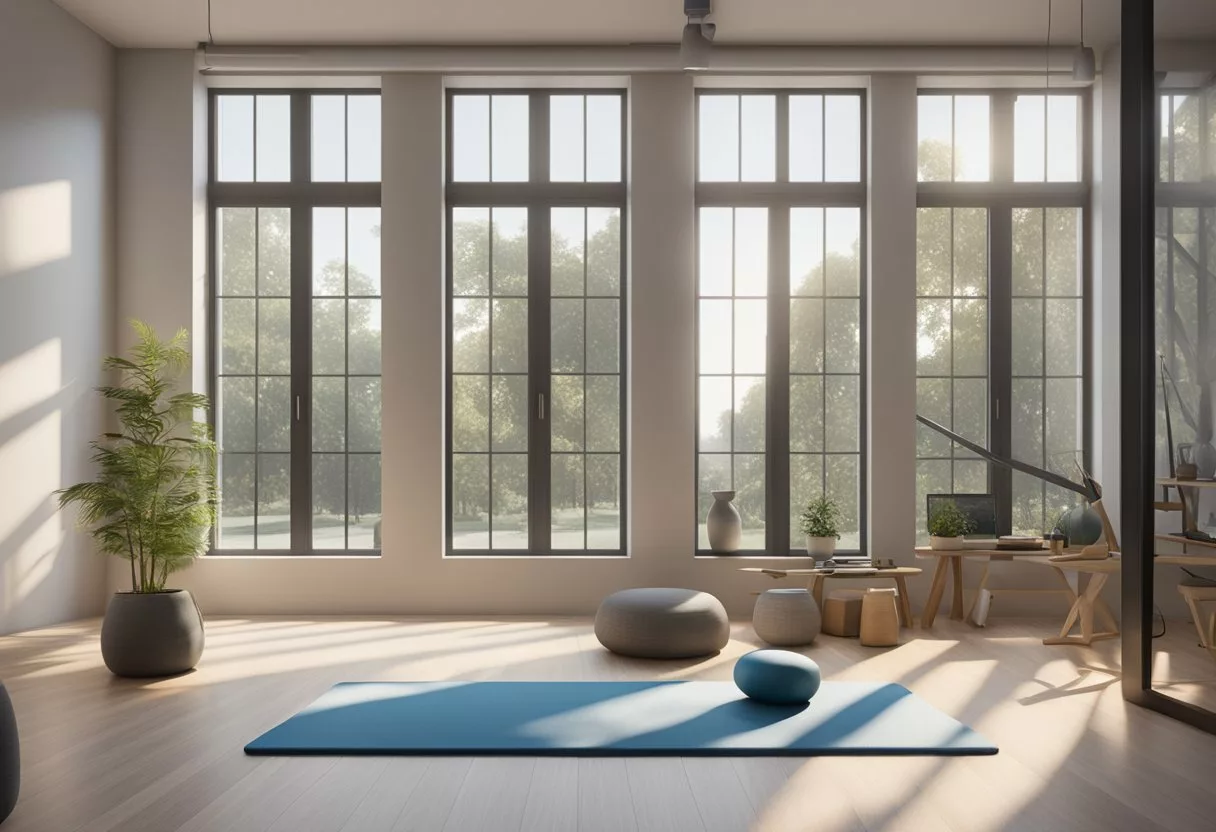
When creating a home workout plan, it’s essential to consider your fitness level, goals, and available equipment.
By setting realistic goals, scheduling workouts, and tracking progress, you can create a workout plan that will help you achieve your fitness goals.
Setting Realistic Goals
When setting fitness goals, it’s essential to be realistic and specific.
For example, a beginner may want to start with a goal of exercising three times per week for 30 minutes each session. As you progress, you can increase the number of days and duration of each workout.
It’s also important to set goals that are achievable and measurable.
For instance, instead of setting a goal to “get in shape,” set a goal to “lose 10 pounds in three months” or “run a 5k in six months.” This way, you can track your progress and stay motivated.
Workout Scheduling
Scheduling workouts is crucial to ensure consistency and progress.
It’s best to schedule workouts at a time when you’re most likely to stick to them. For example, if you’re a morning person, schedule your workouts in the morning.
It’s also important to vary your workouts to prevent boredom and avoid overworking certain muscle groups.
A balanced workout plan should include cardiovascular exercise, strength training, and flexibility exercises.
You can use online resources or consult with a personal trainer to create a well-rounded workout plan.
Progress Tracking
Tracking progress is essential to stay motivated and monitor your progress.
You can use a fitness journal or app to track your workouts, including the exercises, sets, and reps, as well as any notes or observations.
By tracking your progress, you can see how far you’ve come and identify areas where you need to improve. You can also celebrate your successes and use them as motivation to continue working towards your goals.
Warm-Up and Cool-Down Routines
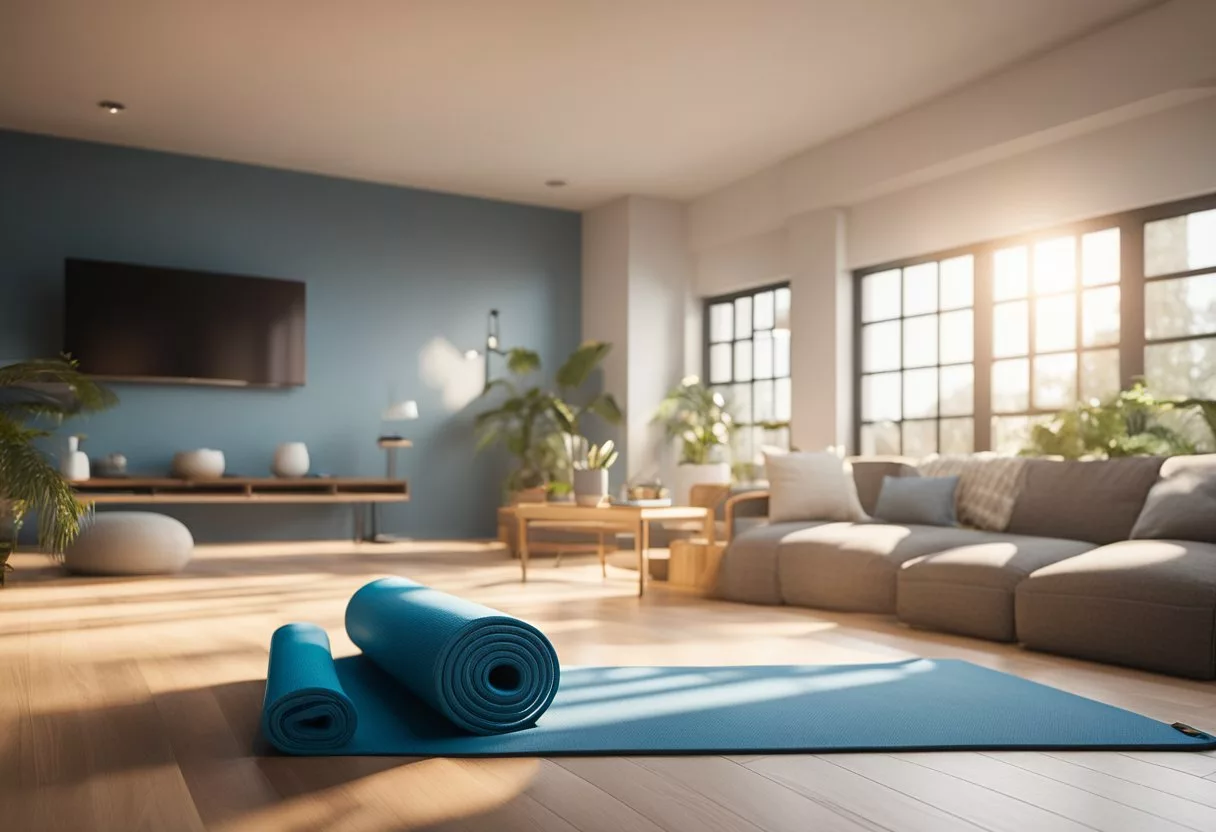
Importance of Warming Up
Warming up is an essential part of any workout routine, whether you’re working out at home or in a gym.
It helps to prepare your body for physical activity by gradually increasing your heart rate, blood flow, and body temperature. This, in turn, helps to reduce the risk of injury and improves your overall performance during the workout.
A good warm-up routine should typically last between 5-10 minutes and include light aerobic exercises, such as jogging, jumping jacks, or cycling.
You could also include dynamic stretching exercises, which involve moving your muscles and joints through a full range of motion, to further prepare your body for the workout.
Stretching for Flexibility
Stretching is an excellent way to improve your flexibility, which is essential for maintaining good posture, preventing injury, and enhancing your overall performance during workouts.
When done correctly, stretching can help to improve your range of motion, increase blood flow to your muscles, and reduce muscle tension.
Some popular stretching exercises include static stretching, where you hold a stretch for a set amount of time, and dynamic stretching, where you move your muscles and joints through a full range of motion.
It is recommended to perform stretching exercises after a warm-up routine or at the end of a workout when your muscles are warm and pliable.
Cooling Down for Recovery
Cooling down is an essential part of any workout routine, as it helps to gradually lower your heart rate, blood pressure, and body temperature, and prevent dizziness or fainting.
A good cool-down routine should typically last between 5-10 minutes and include low-intensity exercises, such as walking or gentle stretching.
Some benefits of cooling down include reducing muscle soreness, improving flexibility, and promoting recovery after a workout.
It is also recommended to hydrate adequately after a workout, as this can help to replenish lost fluids and prevent dehydration.
Bodyweight Workouts

Bodyweight workouts are a great way to stay fit and healthy without the need for any equipment. They are also a convenient option for those who prefer to work out at home or don’t have access to a gym.
In this section, we will discuss some of the best bodyweight exercises that can help you build strength, burn fat, and improve your overall fitness.
Upper Body Exercises
Push-ups are a classic upper body exercise that can help you build strength in your chest, shoulders, and triceps.
To perform a push-up, start in a plank position with your hands shoulder-width apart and your feet together. Lower your body until your chest touches the ground, then push back up to the starting position.
Another great upper body exercise is the plank. This exercise strengthens your core, shoulders, and back muscles.
To perform a plank, start in a push-up position, then lower yourself onto your forearms. Keep your body straight and hold this position for as long as you can.
Lower Body Movements
Squats are one of the best lower body exercises you can do without any equipment. They work your glutes, quads, and hamstrings.
To perform a squat, stand with your feet shoulder-width apart, then lower your body as if you were sitting in a chair. Keep your back straight and your knees behind your toes.
Lunges are another great lower body exercise that can help you build strength and improve your balance.
To perform a lunge, step forward with one foot and lower your body until your front knee is at a 90-degree angle. Keep your back straight and your core engaged.
Core Strengthening
Planks are not only great for your upper body, but they are also an excellent core exercise.
To perform a plank, start in a push-up position, then lower yourself onto your forearms. Keep your body straight and hold this position for as long as you can.
Crunches are another great core exercise that can help you build strength in your abs.
To perform a crunch, lie on your back with your knees bent and your feet flat on the ground. Place your hands behind your head, then lift your upper body towards your knees. Keep your neck and back straight.
Strength Training at Home
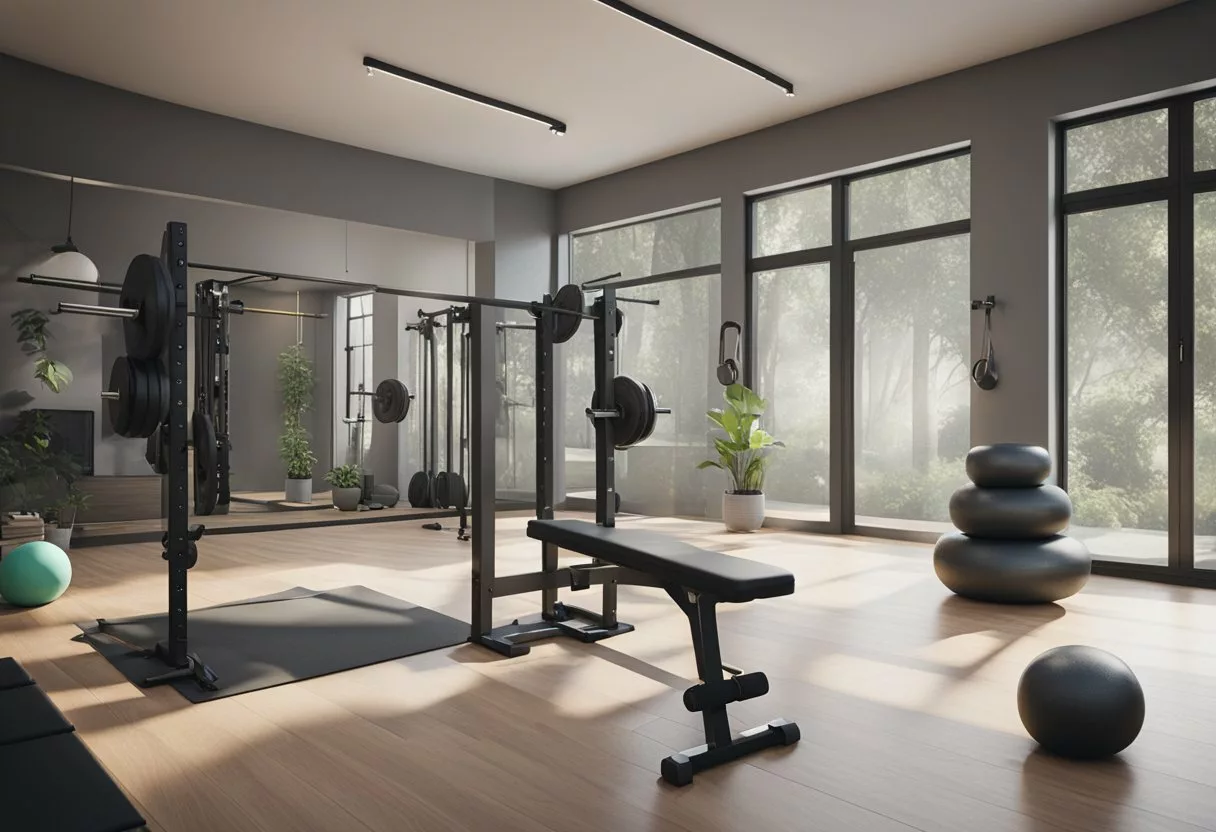
Strength training is an essential component of any fitness program. It helps build muscle, increases bone density, and improves overall health.
With the right equipment and knowledge, you can easily incorporate strength training into your at-home workout routine.
Building Muscle Without Weights
You don’t need weights to build muscle. Bodyweight exercises such as push-ups, squats, and lunges can be just as effective.
These exercises use your own body weight as resistance, making them ideal for at-home workouts.
To increase the intensity of bodyweight exercises, you can add variations such as plyometric movements, such as jump squats and explosive push-ups. This will help build strength and power.
Using Dumbbells and Resistance Bands
Dumbbells and resistance bands are great tools for strength training at home.
They are affordable, take up little space, and can be used for a variety of exercises.
Dumbbells are ideal for exercises such as bicep curls, shoulder presses, and lunges.
Resistance bands are great for exercises such as rows, chest presses, and tricep extensions.
When using dumbbells or resistance bands, make sure to start with a weight that’s comfortable for you. Then, gradually increase the weight as you get stronger.
Advanced Strength Techniques
If you’re looking to take your strength training to the next level, there are several advanced techniques you can incorporate into your at-home workouts. These include:
- Supersets: Performing two exercises back-to-back with no rest in between.
- Drop sets: Performing an exercise with a heavy weight, then immediately reducing the weight and performing the exercise again.
- Negatives: Focusing on the eccentric (lowering) phase of an exercise to build strength.
Incorporating these advanced techniques into your at-home workouts will help you break through plateaus and continue to make progress.
Cardiovascular Exercises for Fat Loss

Cardiovascular exercises are an effective way to burn calories and lose fat.
Incorporating cardio into an at-home workout routine can help increase heart rate, sweat production, and ultimately lead to fat loss.
Here are some of the best cardio exercises for fat loss:
High-Intensity Interval Training
High-Intensity Interval Training (HIIT) is a popular cardio workout that alternates between high-intensity exercises and rest periods.
HIIT workouts are known for their ability to burn fat quickly, as they increase heart rate and metabolism.
Some popular HIIT exercises include jumping jacks, burpees, and mountain climbers.
HIIT workouts can be done with little to no equipment, making them perfect for at-home workouts.
Steady-State Cardio Options
Steady-state cardio involves maintaining a consistent level of intensity throughout the workout.
This type of cardio is effective for burning calories and can be done with a variety of exercises, including jogging, cycling, and swimming.
Steady-state cardio workouts can be done with or without equipment and are a great option for those looking to improve endurance.
Cardio for Endurance
Cardio for endurance involves performing exercises for an extended period of time, usually 30 minutes or more.
This type of cardio is effective for improving cardiovascular health and can lead to increased fat loss over time.
Some popular endurance exercises include running, cycling, and rowing.
Endurance workouts can be done with equipment or without, depending on personal preference.
Targeted Workouts for Specific Muscle Groups
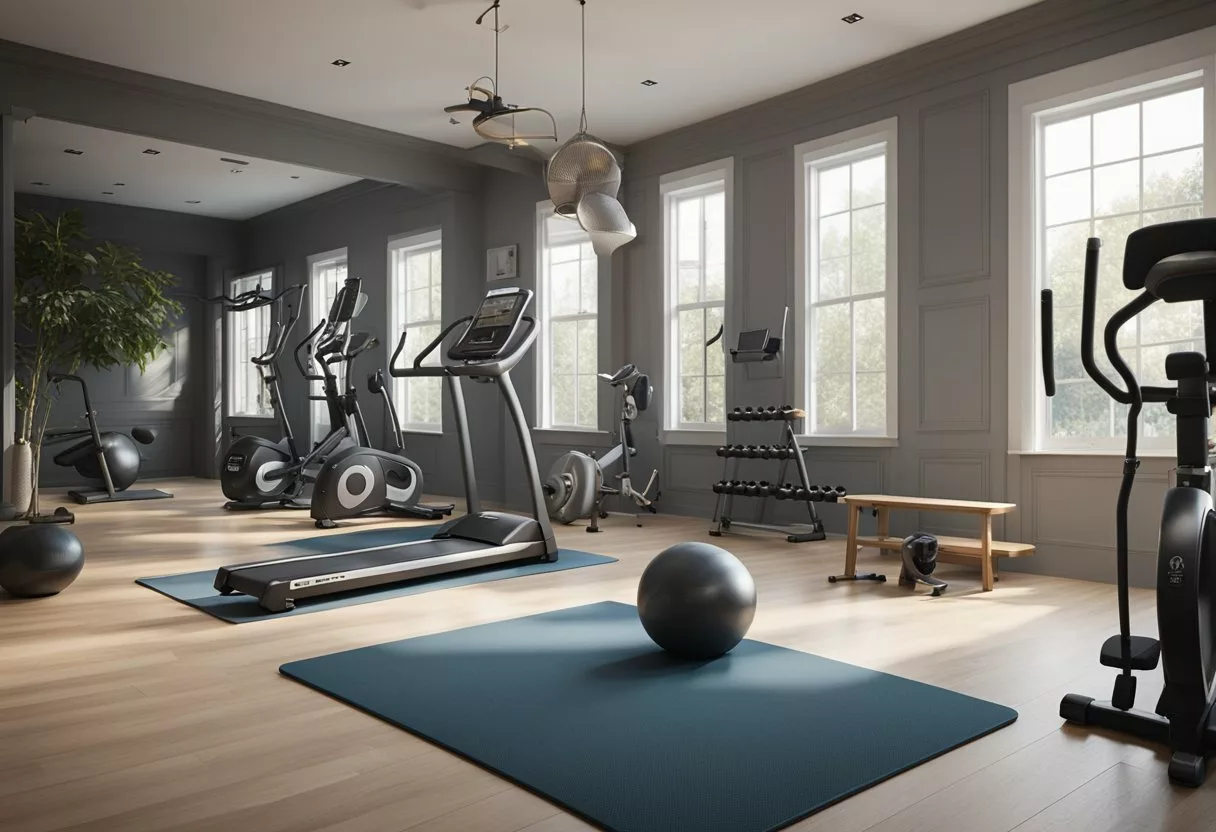
When it comes to at-home workouts, it’s important to focus on specific muscle groups to achieve the best results. Here are some targeted workouts for specific muscle groups that can be done at home with little to no equipment.
Chest and Shoulders
To target the chest and shoulders, push-ups are an effective exercise that can be done anywhere.
Variations such as diamond push-ups, incline push-ups, and decline push-ups can target different areas of the chest and shoulders.
Another exercise that can target the shoulders is the shoulder press, which can be done with dumbbells or resistance bands.
Back and Lats
To target the back and lats, pull-ups and chin-ups are great exercises that can be done with a pull-up bar or even a sturdy tree branch.
If a pull-up bar is not available, rows can be done with dumbbells or resistance bands.
Bent-over rows, renegade rows, and single-arm rows are all great variations to target different areas of the back and lats.
Arms and Legs
To target the arms and legs, bodyweight squats, lunges, and calf raises are great exercises that can be done anywhere.
For the arms, push-ups, dips, and tricep extensions can be done with little to no equipment.
Bicep curls, hammer curls, and concentration curls can be done with dumbbells or resistance bands.
It’s important to keep in mind that targeted workouts for specific muscle groups should be combined with full-body workouts for optimal results. By targeting specific muscle groups, individuals can achieve a balanced and well-rounded physique.
Tips for Beginners
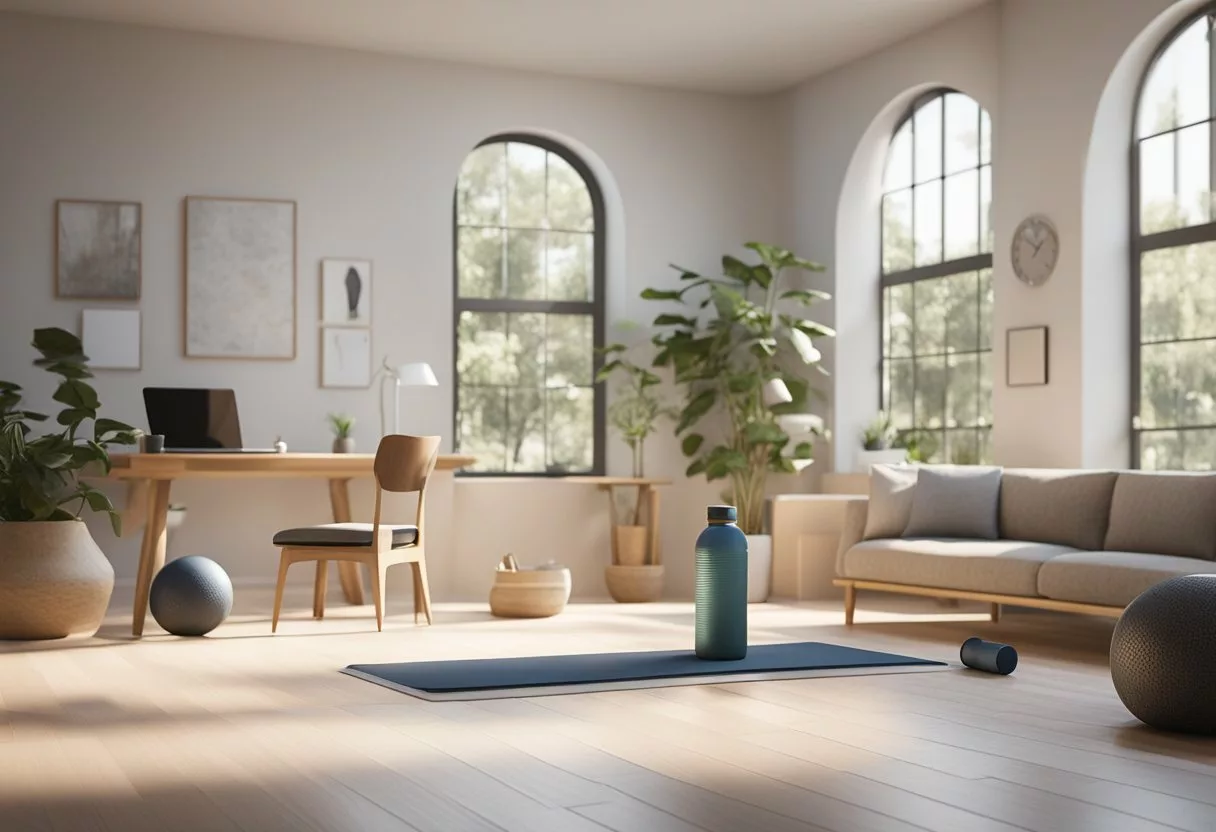
Starting an at-home workout routine can be challenging, especially for beginners. However, with the right approach, anyone can achieve their fitness goals. Here are some tips to help beginners get started on the right track.
Understanding Proper Form
One of the most important things for beginners to understand is proper form.
Correct form not only helps prevent injuries but also ensures that the targeted muscles are being worked effectively.
It is recommended to start with bodyweight exercises and focus on mastering the correct form before adding weights or increasing intensity.
Starting with Low Intensity
Beginners should start with low intensity. This means starting with exercises that are not too challenging. Then, they can gradually increase the intensity as fitness levels improve.
It is recommended to start with simple movements such as squats, lunges, push-ups, and planks. These exercises target multiple muscle groups and can be done without any equipment.
Learning Basic Movements
Learning basic movements is also important for beginners. This includes understanding the difference between compound and isolation exercises.
Compound exercises work multiple muscle groups at once, while isolation exercises target a specific muscle group. It is recommended to start with compound exercises as they are more efficient and effective for beginners.
Progressing to Intermediate and Advanced Levels
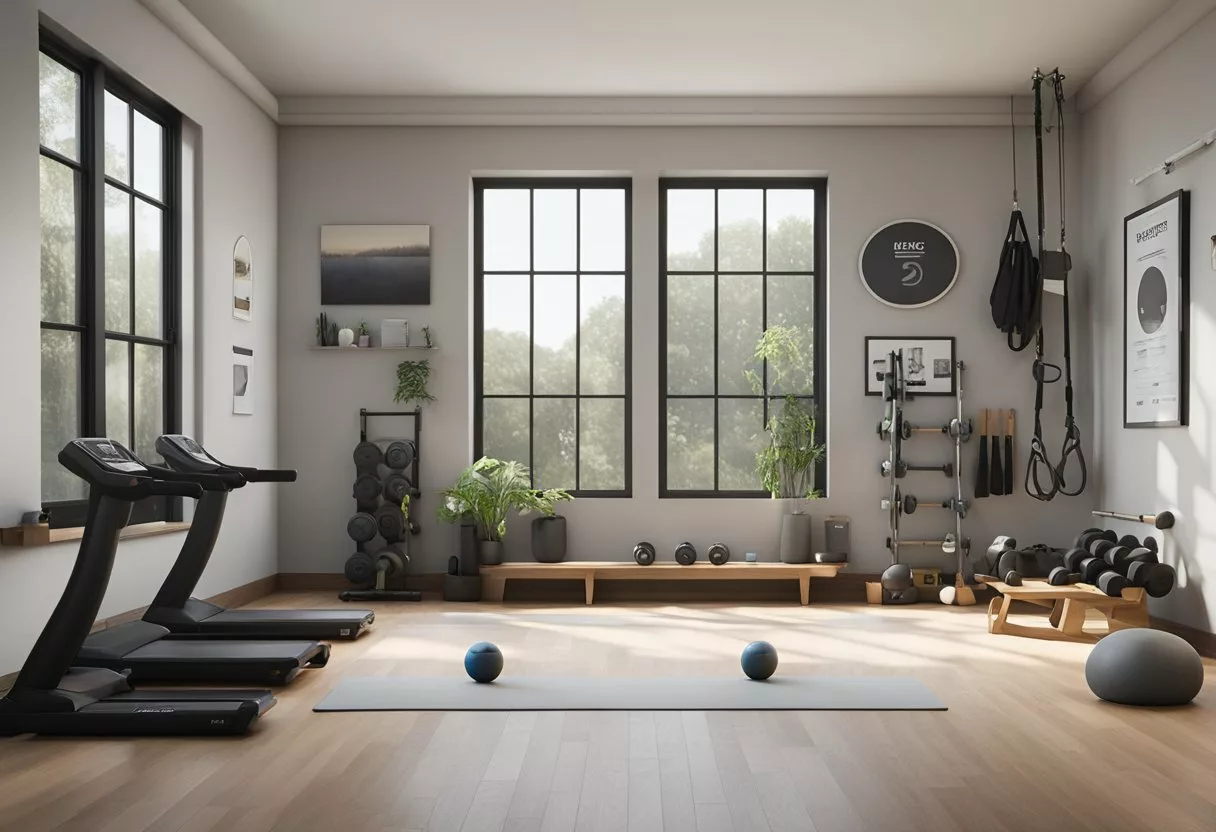
To keep seeing results and avoid plateauing, you need to progressively increase the intensity of your workouts. Here are some ways to progress to intermediate and advanced levels:
Increasing Intensity
One way to increase intensity is to add more reps or sets to your workout. For example, if you’re currently doing 3 sets of 10 reps for an exercise, you could increase to 4 sets of 12 reps.
Another way to increase intensity is to decrease your rest time between sets. This will make your workout more challenging and keep your heart rate up.
Complex Exercise Variations
Another way to progress is to incorporate more complex exercise variations. For example, if you’ve been doing regular push-ups, try incorporating diamond push-ups or decline push-ups.
These variations will challenge your muscles in new ways and help you progress to more advanced exercises.
Incorporating Weights and Equipment
Incorporating weights and equipment is another way to progress to intermediate and advanced levels. Adding dumbbells, resistance bands, or kettlebells to your exercises will challenge your muscles and help you build strength.
For example, adding dumbbells to your lunges or squats will make them more challenging and help you progress.
Frequently Asked Questions
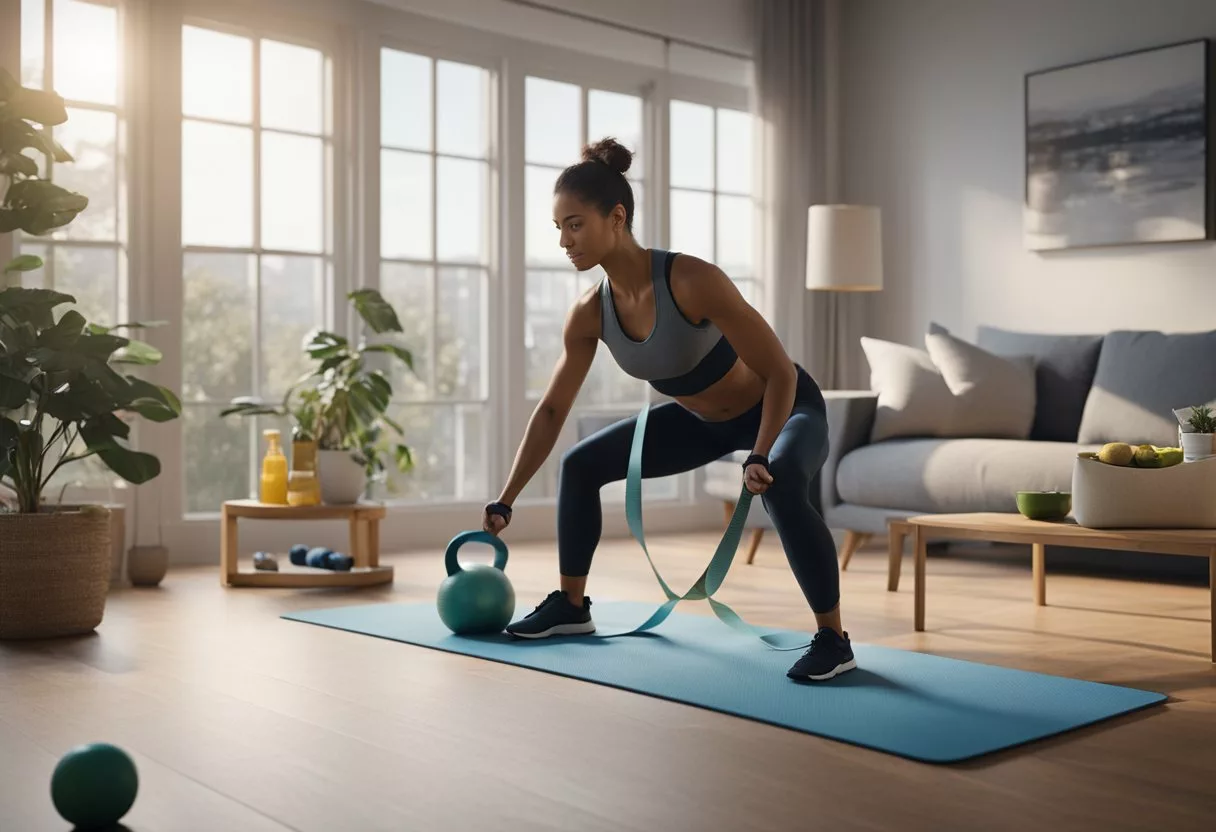
What are some effective full-body workouts that can be done at home without equipment?
There are several exercises that can be done at home without equipment that target multiple muscle groups and provide a full-body workout. These include bodyweight squats, lunges, push-ups, planks, and burpees.
By combining these exercises into a circuit, you can create a challenging and effective workout that can be done in a small space.
How can women tailor their home workouts to focus on weight loss?
Women can focus on weight loss by incorporating high-intensity interval training (HIIT) into their home workouts. HIIT involves short bursts of intense exercise followed by periods of rest or low-intensity exercise.
This type of training has been shown to be effective for burning fat and increasing metabolism. Additionally, women can incorporate exercises that target large muscle groups, such as squats and lunges, to increase muscle mass and burn more calories.
What are some key exercises for building muscle at home for men?
Men can build muscle at home by incorporating exercises that target specific muscle groups, such as push-ups, pull-ups, squats, lunges, and dips.
By increasing the intensity of these exercises, such as by adding weight or increasing repetitions, men can build muscle mass and strength.
Can you provide a structured workout plan suitable for beginners to follow at home?
A structured workout plan for beginners at home can include a combination of bodyweight exercises and cardio.
For example, a beginner’s workout plan could include 3 sets of 10 reps of bodyweight squats, lunges, push-ups, and planks. Then, they can follow this with 20 minutes of cardio, such as jumping jacks or jogging in place.
As the beginner becomes more comfortable with these exercises, they can increase the intensity and duration of the workout.
How can I maximize fat loss with at-home exercises?
To maximize fat loss with at-home exercises, you need to incorporate both cardio and strength training into your workout routine.
HIIT workouts are particularly effective for burning fat, as they increase metabolism and burn calories even after the workout is over.
Additionally, incorporating exercises that target multiple muscle groups, such as burpees or mountain climbers, can help to increase calorie burn and promote fat loss.
What is the best way to achieve fitness at home within two weeks?
Achieving fitness at home within two weeks requires a combination of exercise and healthy eating habits. To maximize results, incorporate both strength training and cardio into your workout routine.
Additionally, focus on eating whole, nutrient-dense foods and avoid processed and sugary foods to support your fitness goals.
Remember that fitness is a journey, and consistency and patience are key to achieving long-term results.
